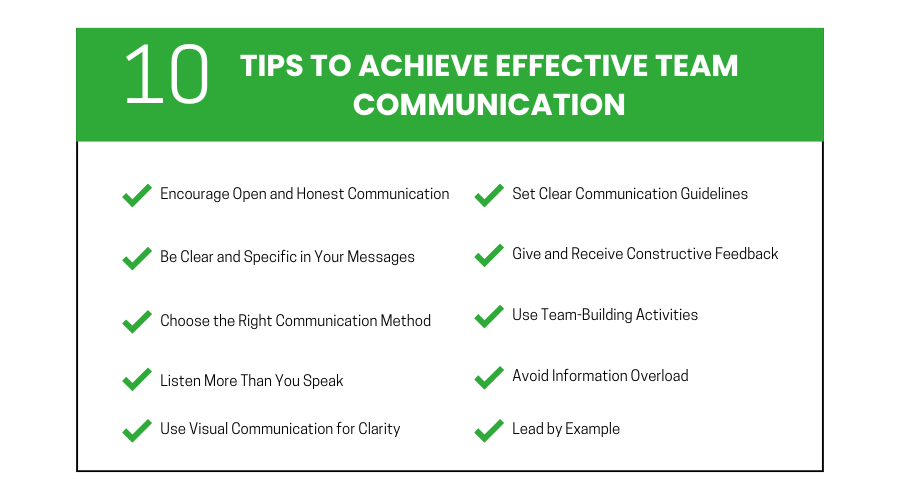Effective team communication is essential for a productive, engaged, and successful workplace. When teams communicate well, collaboration improves, misunderstandings decrease, and overall efficiency rises. However, poor communication can lead to confusion, frustration, and workplace conflicts.
If you want to build a stronger, more connected team, check out these 10 actionable tips for effective team communication. You can also read the full guide on team communication for more insights.
1. Encourage Open and Transparent Communication
One of the biggest barriers to effective team communication is a lack of openness. When employees feel hesitant to share their thoughts, ideas, or concerns, the workplace becomes less collaborative.
✔️ Foster an open-door policy where employees feel comfortable expressing their opinions.
✔️ Encourage honest feedback between employees and management.
✔️ Create a safe space for discussions, ensuring no one fears judgment.
A transparent work environment boosts trust and ensures that communication flows smoothly at all levels.
2. Use the Right Communication Tools
With remote work and global teams becoming more common, relying on emails alone isn’t enough. Having the right tools can significantly improve how teams interact.
???? Use Slack, Microsoft Teams, or Zoom for real-time messaging and video calls.
???? Implement project management tools like Asana, Trello, or Monday.com for task tracking.
???? Utilize Google Docs or Notion for easy document sharing and collaboration.
Selecting the right communication channels ensures that important messages don’t get lost and teams stay aligned.
3. Hold Regular Team Meetings
Meetings are essential for keeping teams connected and updated. However, unproductive meetings can waste time and lead to disengagement.
✔️ Schedule weekly or biweekly team meetings to discuss progress and challenges.
✔️ Keep meetings short, focused, and structured with a clear agenda.
✔️ Allow everyone to contribute instead of just one person leading the conversation.
Consistent meetings ensure that everyone stays informed and engaged while reducing workplace silos.
4. Practice Active Listening
Communication isn’t just about talking; it’s also about listening actively. Often, misunderstandings occur because employees don’t feel heard.
???? Maintain eye contact and focus on the speaker.
???? Avoid interrupting or thinking about your response while someone else is speaking.
???? Summarize or repeat key points to show you understood.
Active listening fosters respect and clarity, ensuring that conversations are meaningful and effective.
5. Encourage Feedback and Constructive Criticism
A feedback-friendly culture allows employees to improve and grow. When feedback is ignored, mistakes repeat, and performance declines.
✅ Offer regular performance feedback instead of waiting for annual reviews.
✅ Encourage peer-to-peer feedback to improve collaboration.
✅ Focus on constructive criticism rather than personal attacks.
Employees who receive clear, actionable feedback are more motivated and engaged in their work.
6. Be Mindful of Nonverbal Communication
Did you know that 55% of communication is nonverbal? Body language, tone, and facial expressions often convey more meaning than words alone.
✔️ Maintain positive body language to show engagement.
✔️ Avoid crossing arms or frowning, as these can appear defensive.
✔️ Use a calm and friendly tone in conversations.
Understanding nonverbal cues improves communication clarity and helps avoid misunderstandings.
7. Set Clear Expectations and Guidelines
Miscommunication often happens when roles, responsibilities, and expectations aren’t well-defined.
???? Clearly outline each team member’s role and duties.
???? Set realistic deadlines and priorities to avoid confusion.
???? Use written documentation to reinforce verbal instructions.
When expectations are clear, teams become more accountable and efficient in their work.
8. Adapt Communication to Different Personalities
Every team consists of different personality types, and not everyone communicates in the same way. Some employees prefer direct conversations, while others work better with written instructions.
✅ Identify whether your team members are visual, auditory, or kinesthetic learners.
✅ Adjust your approach based on whether someone prefers emails, face-to-face talks, or group meetings.
✅ Respect introverts and extroverts, ensuring both feel comfortable expressing themselves.
Personalized communication makes interactions more effective and meaningful.
9. Resolve Conflicts Professionally and Quickly
Workplace conflicts are inevitable, but how you handle them determines team harmony. Unresolved conflicts can damage team morale and productivity.
✔️ Address conflicts immediately instead of letting them escalate.
✔️ Focus on solutions rather than blame.
✔️ Encourage a neutral third party (such as HR) to mediate if necessary.
Healthy conflict resolution strengthens team relationships and promotes a positive work culture.
10. Promote Team Bonding and Engagement
Strong team communication isn’t just about work discussions—it’s also about building relationships. Employees who feel connected to their colleagues communicate more effectively.
???? Organize team-building activities, such as game nights or virtual hangouts.
???? Encourage informal chats to build friendships.
???? Celebrate team achievements and milestones together.
When employees feel valued and included, they become more engaged and willing to communicate openly.
Final Thoughts
Effective team communication is the foundation of a successful and high-performing workplace. By implementing these 10 strategies, businesses can create an environment where collaboration, clarity, and trust thrive.
If you’re looking to enhance communication within your team, check out this detailed guide on achieving effective team communication for more expert tips.
???? How do you ensure effective communication in your workplace? Share your thoughts below!